With the impending stretch of bad weather, the utter lack of all things right whale, and the end of the season drawing near anyway, we decided to call our 2014 Bay of Fundy field season officially over. I will be heading back to Syracuse not entirely empty handed, though with admittedly far less data than I had hoped…anyway, that’s it on the right whale field work until January, so check back then!
Private: News and Events
Oh hi, cachalot
While our team spotted no right whales in the Bay yesterday (the other teams combined found 4-6) I finally got my sperm whale encounter! Granted all I saw of it were its flukes, and I didn’t even get a picture…so here is one from Arkive.

From as far away as we were, and being that the flukes were pretty unremarkable, we weren’t positive at the time that what we had was in fact a sperm whale. Well considering they can stay down for over an hour, we were either going to have to assume that it was (which is bad form) or we could do what we do best and drop a hydrophone over the side of the boat to listen. And that is what we did. And this is what we heard.
Using a spectrogram, we can visualize what we are hearing as well. Here is a spectrogram of the above audio clip.
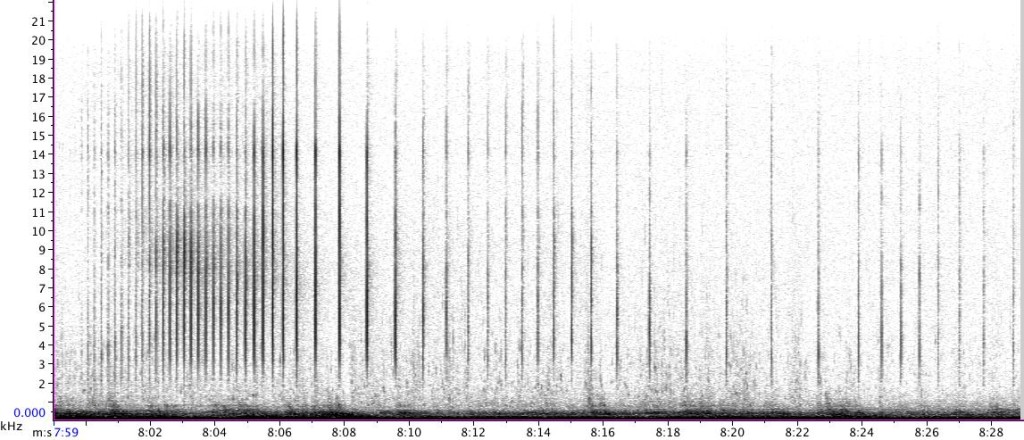
This animal was likely a male – mature male sperm whales forage at higher latitudes, often alone, while the larger pods consisting of females, calves, and juveniles spend all of their time in the tropics and sub-tropics. Sperm whale social vocalizations include stereotyped, repetitive patterns of clicks called codas. The solidarity of the males in these higher latitude habitats means that their vocal repertoire is different than that of the female/calf/juvenile social groups – codas are not heard here. The clicks we were hearing from our whale were therefore likely being used for echolocation while the animal was searching for food. Pretty neat, yes? Yes.
So while we are bummed about the paucity of right whales, I got to hear a sperm whale that was somewhere below me. I’ll take it.
Right whales, great friends, and…pirates?
This has been a great past few days and for two very different reasons!
Thursday started out like any marginal boat day: getting up early and looking at the weather, then looking at it every 15 minutes to see if it has changed or not, for better or worse. We had just made the decision not to go when Marianna came dancing (quite literally) into the kitchen. The folks from Grand Manan Whale and Seabird Research Station had called on the radio and were out in the Bay with a potential mother/calf right whale pair! Just to brag a bit, from the time we got the call until we were on scene was only about an hour and 15 minutes. We were on our GAME. And obviously more than a little excited to finally have an opportunity to do what we came for: tag a right whale mom or calf.
When we got there we expected just a mom/calf pair. What we found instead were 5-8 right whales all in the same area, even grouped up together at times. We saw the animal the GMWSRS team said could be a calf, and although it was a bit bigger than the calves usually are around here, it was definitely a young animal. The pretty big swell we were in was making it very difficult to even see all of the whales around, so we knew we needed to really act fast in order to get a tag on. We really were on our game. We got our tag on and the placement was perfect. Not that we expect much less from Alex of course. No sooner did we get our tag on though did the whales dive, and were gone.

That’s the problem with whales. They can disappear. I have mentioned this before, and I will say it again for those disbelievers, it is so easy to lose a whale. And that swell we were in? Oh that does not help, not at all. We had all of our tracking equipment out and were getting hits from our dear tag (it was of course Scoby), however if we were in the bottom of the swell we were obscured from the transmitter on the tag and it was difficult to get a “hit”. We equipped the Nereid with our other set of tracking gear and had Heather Koopman and Andrew Westgate from GMWSRS keep an ear out on their equipment too just for good measure. Turns out Andrew, one of their senior scientists, is not only very VERY good at tracking, he LOVES it. Guess who found it first…it is always nice to have great friends that are willing to help out in the name of science. First round is on us guys.
To add to our good mood and high spirits, yesterday was the annual “Pirate Invasion” where the town of Eastport “invades” Lubec. In other words, everyone from both towns dresses up as pirates and those from Eastport head over by boat, motorcycle, and sea plane where we attempt to fend them off with water guns and water balloons. We inevitably fail, and then there are festivities to be shared by both Lubecers and Eastporteans alike. Being such a windy day, we were on land for it again this year and were able to partake.
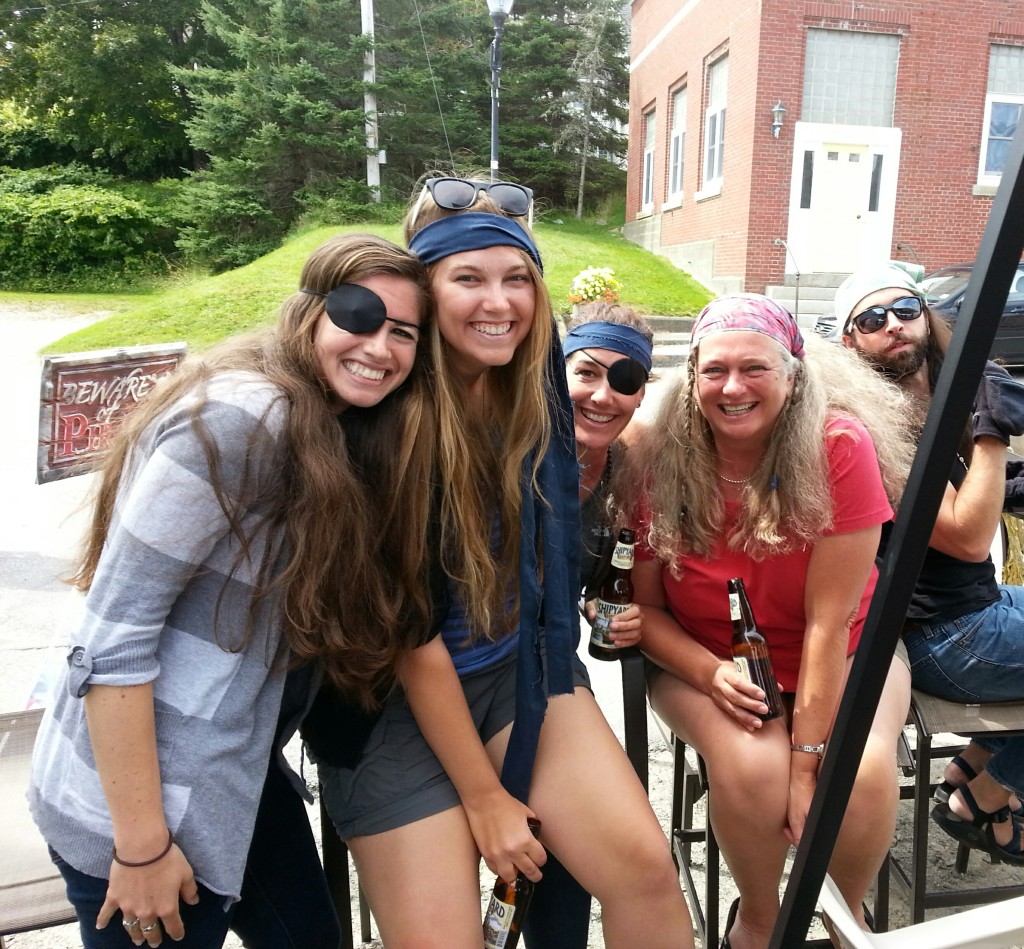
We won’t be out tomorrow, but Tuesday looks promising. Hopefully the whales have stuck around! Until then, insert cliche, cheesy pirate goodbye here – something using the words “arr”, “matey”, and “Davey Jones’ locker”.
A day trip to Harvard Forest
I like to think of myself as an outdoorsy person. I try to get away from it all a couple times a week. Mostly I go mountain biking, but I also run and hike on forest trails. In addition to the enjoyment I get from these activities, I like to listen to the environment. I enjoy being in an area where I cannot hear human activities. Where the dominant sound is contributed by something – insects, birds, frogs, wind, rain or whatever happens to be around – that is not “us”. Hearing plays a large role in my perspective of a location. There is currently a disconnect between my eyes and my ears when I walk into the lab. I walk into the lab and I see desks and workbenches, but I hear a meadow in summer. Actively listening to one’s environment can have a profound impact on the way in which we experience our world. As we welcomed the students back to campus, I have noticed the sheer number of individuals who walk around actively isolating themselves from the sounds in their environment. I don’t care for the sounds of cars driving by, emergency vehicle sirens blaring, or the constant hum of HVAC equipment – but at what cost are we drowning out those sounds with our personal playlists. Perhaps it is the curmudgeon in me, but the number of people walking around with headphones gives me trouble. There is a wonderful world around us, we just have to open our eyes, ears, and minds and experience it. It is this perspective that makes me grateful for the opportunities I have to experience nature.
This week, Hannah and I headed out to Harvard Forest to service the acoustic recorder deployed there. It was my first time going to the site and I was surprised. Rural Massachusetts is beautiful country. From the colonial style houses to the pastoral views, and the turkeys hanging out in the road, the drive to the site was quite enjoyable.

Harvard Forest is a research forest administrated by Harvard University. Since 1907 researchers have been using the forest to study the ways various physical, biological, and human systems impact the earth. We have deployed an acoustic recorder as part of the NEON project and I will be spending the next year trying to extract as much information about the acoustic activity of birds, frogs, and insects as I can. Most of my effort is made from the “comfort” of an office. As an acoustician, most of my time is spent in front of a computer, analyzing recordings and writing up my findings. So I relish every chance I get to go into the field.

We first stopped off at the Harvard Forest research offices to grab the charged batteries. Once we got the batteries, we headed to the recorder. When we arrived at the path to where the recorder is deployed, the first thing we noticed was the presence of a work crew. Perhaps some new sensor was being deployed, so the work crew was installing the instrumentation and some new wiring. The elevated path/gangway had some of the grates missing, making what would be a really easy walk into a really easy walk with some sections of balance beam practice.
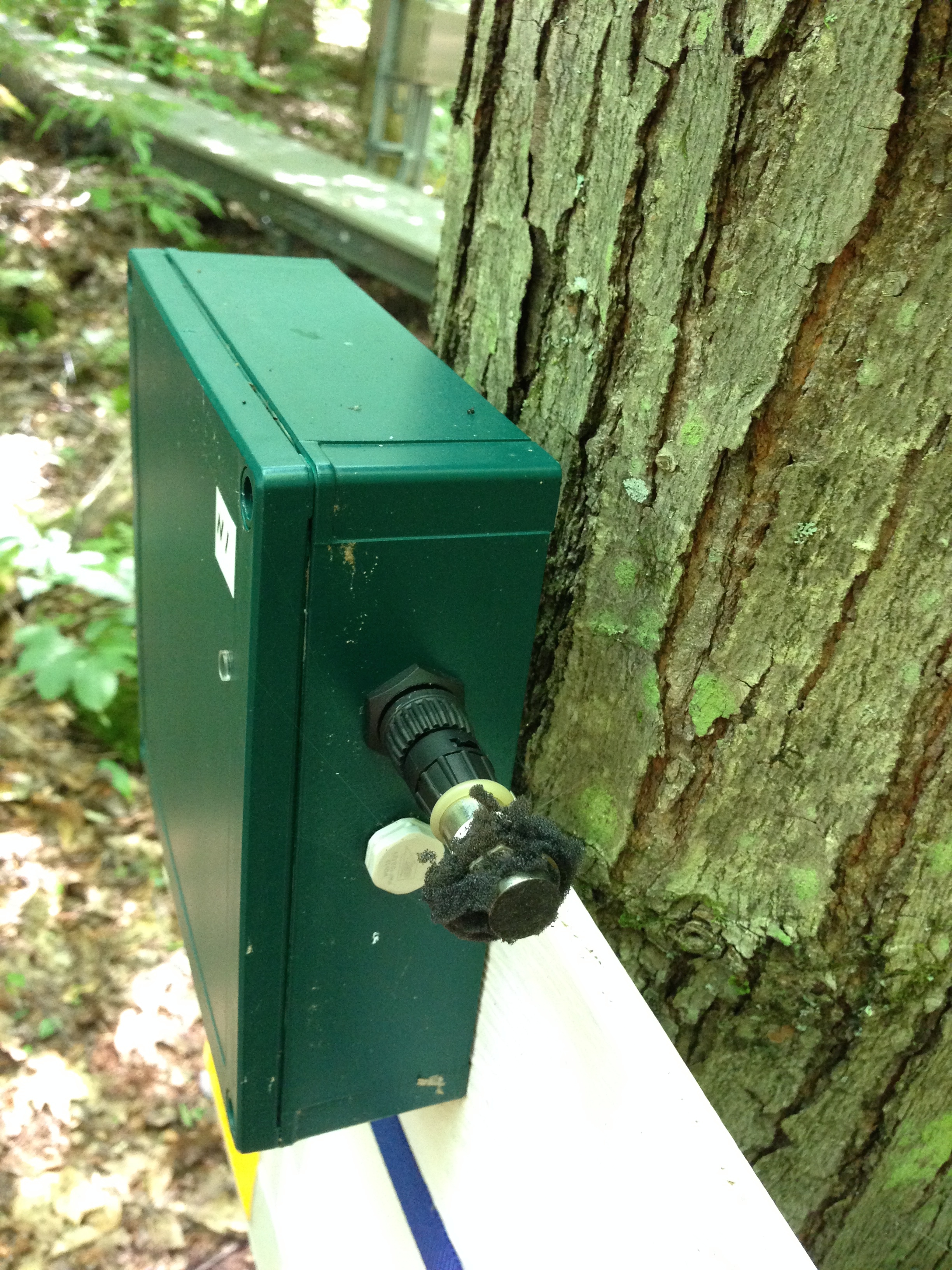
After our harrowing journey through the balance beam gauntlet, we got to the recorder. Everything looked ok from a distance, but upon closer inspection, the recorder was not on, and the microphone windscreens (the foam covers for microphones) had seen better days. As it turns out, those windscreens won’t quite make it through a year. The recorder was off because the data cards were full. We switched out the data cards, changed the batteries, put on new windscreens, and changed the gain (the record volume). It sounds like a lot, but it went really quickly and we were back on the road in no time. We drove back to Syracuse and despite the long day of driving I was thankful for the opportunity to get into the field, if only for a brief while.

-Sam
Why sperm whales are bad news
Well, for us anyway. And squid. And Captain Ahab.
We just had our first two days out in the Bay for the 2014 season, and while we saw many species, we only saw 3 or 4 right whales. None of which were a mom/calf pair. The other two teams had similar luck, with a combined total of less than 10 right whales between all three of us over a two day span. We surveyed pretty much everywhere we could in the Bay too so it seems, for the moment at least, the right whales have left the party. That isn’t to say they won’t come back of course, but the sperm whales have moved in…cue creepy music.
Why is that so bad? Sperm whales are cool, right?? Well sure, but here in the Bay of Fundy it means that things are changing. Up until just a few years ago, only a single sperm whale had been documented here since 1980. And it was just a few years ago that we started to have such a drop in right whales sightings here in the Bay. It isn’t that the sperm whales are driving the right whales away, but they definitely do seem to move in as the right whales move out. Since these guys eat squid, not copepods like right whales, our scientist colleagues think it likely indicates a shift in the entire food chain, and not mere coincidence. Eek.
Anyway, I still haven’t actually had the opportunity to ever SEE a sperm whale, so I am still hoping to get that chance this year. Bad news or not, they really are pretty neat. I imagine seeing one will obviously go something like this:

Species list for the first two days out: right whales, fin whales, humpback whales, minke whales, Atlantic white-sided dolphins, harbor porpoise, basking sharks, ocean sunfish, grey seals, one bald eagle, puffins, and countless other seabirds that I am lumping together for lack of any solid personal interest…
One more round
I arrived back in the Bay of Fundy Thursday night for our last field season here on the mom/calf project. The New England Aquarium has been here for about 2 weeks and have had much greater success than last year already (read all about it in their blog). There have been a couple of sightings of mom/calf pairs but these reports are over a week old now. We are still very, very optimistic that this will turn out to be a great season full of whales though! Considering our team didn’t see a single right whale last year in the Bay, I think the odds are high.
Although, in the words of Han Solo, never tell me the odds…check back soon!
The Parks Lab at the Animal Behavior Meeting
This past week, Dana, Hannah and I travelled to Princeton, NJ for the 51st annual meeting of the Animal Behavior Society. It was only my second time attending the meeting, and a first for both Hannah and Dana. The setting at Princeton University was beautiful, though it did take a day or so to orient to the circuitous routes around campus. The first day I felt as thought I was inside some sort of 19th century maze. My niece and nephew are current students at Princeton, and my brother and his wife both attended, so it was fun to see where they all went to school.

For those not familiar with the Animal Behavior Society, it is an organization founded in 1964, to study all aspects of Animal Behavior in all species. For example, at this meeting, there were scientific presentations on a range of topics from gene expression related to behavior in swordtail fish to documentation of an infanticide attempt in dolphins. The species covered the full range from small insects (even a talk on mosquitos) to some of the largest animals on the planet (elephants and our presentations on humpback and right whales).

The meeting was much larger than the last one I attended, with 5 concurrent sessions of talks running most of the day, and poster sessions from 7-9pm in the evenings. It made for long days with lots of science. We all had great interest in our posters, sticking with a Syracuse University theme to link our three posters together.
One of the highlights of the meeting for us was interfacing with the members of the Schul Lab at the University of Missouri. Two of the groups’ graduate students had posters directly across from ours leading to long discussions about our forays into insect research. We picked up several very useful tips. For example, Meadow Katydids like to eat horse meat (NOT what we’ve been feeding them) and katydids are easiest to catch at dusk in the evening when they aren’t actively moving behind vegetation to hide from would-be katydid catchers in the field. Dana and I also, sadly, had to mostly claim ignorance for the scientific names of our study species (a faux pas in any field of biology, but doubly so with insects!). Hannah made us proud though, with her encyclopedic knowledge of scientific names. We’re excited about staying in touch with this research group as we venture into the world of katydid research.
-Susan
Bioacoustics in the Classroom
Who knew insects could be so useful?
Last week, the Parks lab lent a hand to the Summer Science Institute held here in the Syracuse University Biology Department. This program introduces high school students to some of the ways science is done here at the university, using short lectures, demonstrations and hands-on activities. It’s a great way for the students to get some early exposure to science, and is also something they can put on college applications.
Until the past year most of the bioacoustics research done in our lab involved only marine mammals, which are large, require a lot of permits, and are not located in upstate New York. Read: not very amenable to hands-on high school-level activities. Luckily, since we’re smack in the middle of our second insect field season, we have over 100 acoustically-signaling katydids and crickets right here in the lab. Much more practical!
We started our program with some short talks on animal communication and insect diversity, followed by a game of “guess the insect.” This activity involved seven cardboard boxes hiding seven insects, which the students had to try to determine were either katydids or crickets just by the sound of their calls. When we lifted the boxes they seemed to get a kick out of examining the insects up close, and from a perspective not of “ew, a bug!” but as animals and research subjects.
Next we took them out to a nearby park to make their own recordings, both of any animals calling and the anthropogenic (human-generated) noise around them. The two girls I was chaperoning were tasked with recording anthropogenic noise, but after getting some good clips we started listening for animals as well (they wanted to find some crickets – who was I to deny them?). Instead, some of the other students called us over to an awesome find – two eclosing annual cicadas!
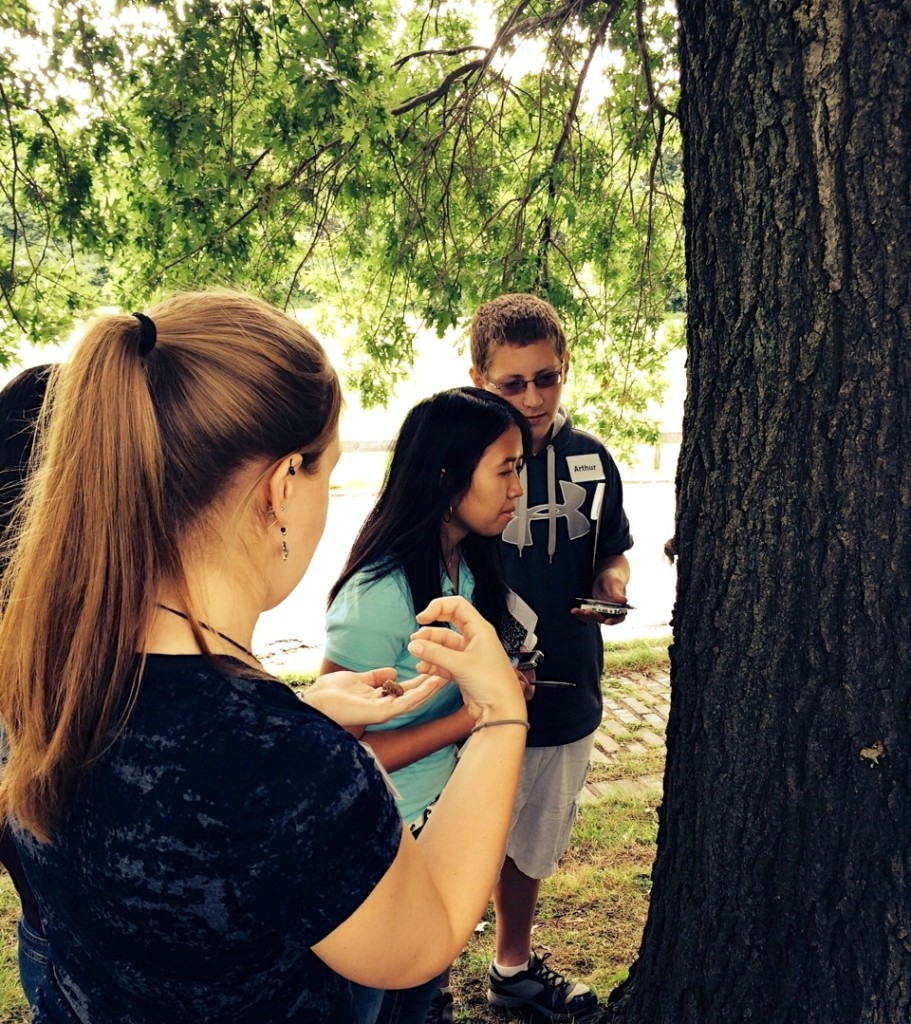
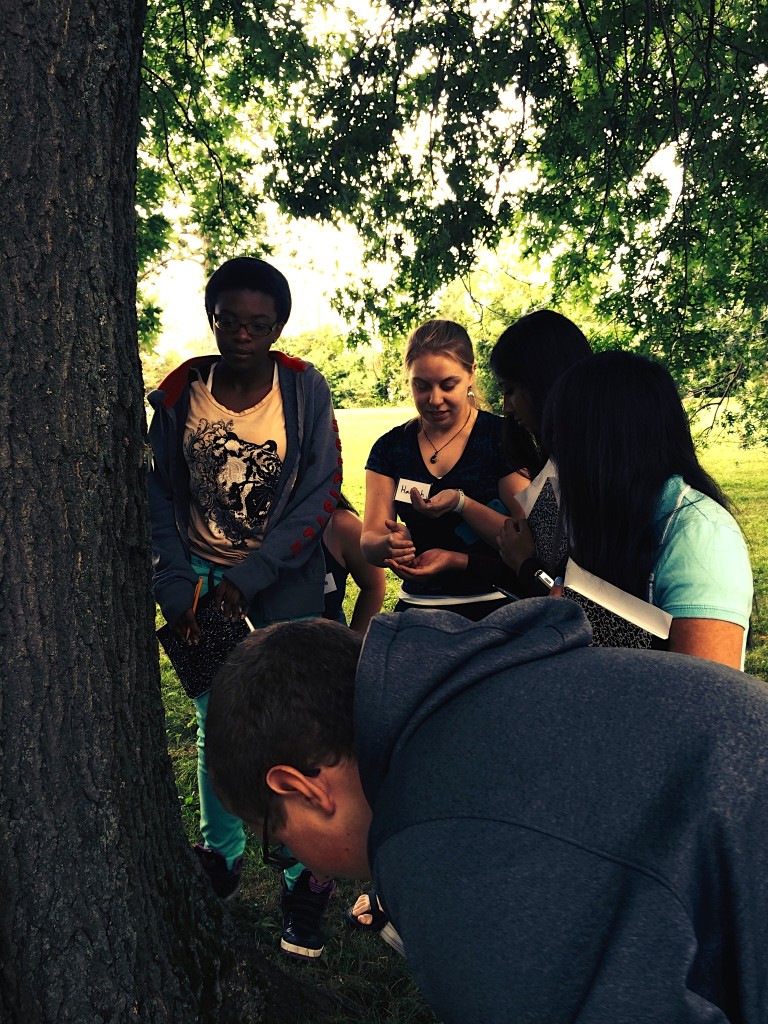
The students who crowded around the tree were clearly fascinated by the cicadas and their recently-vacated exoskeletons. They continued watching the eclosure process to its conclusion while I shared more cicada info. Molting cicadas come straight out of the back of their exoskeletons, and the students were concerned that they would fall out and onto the ground!
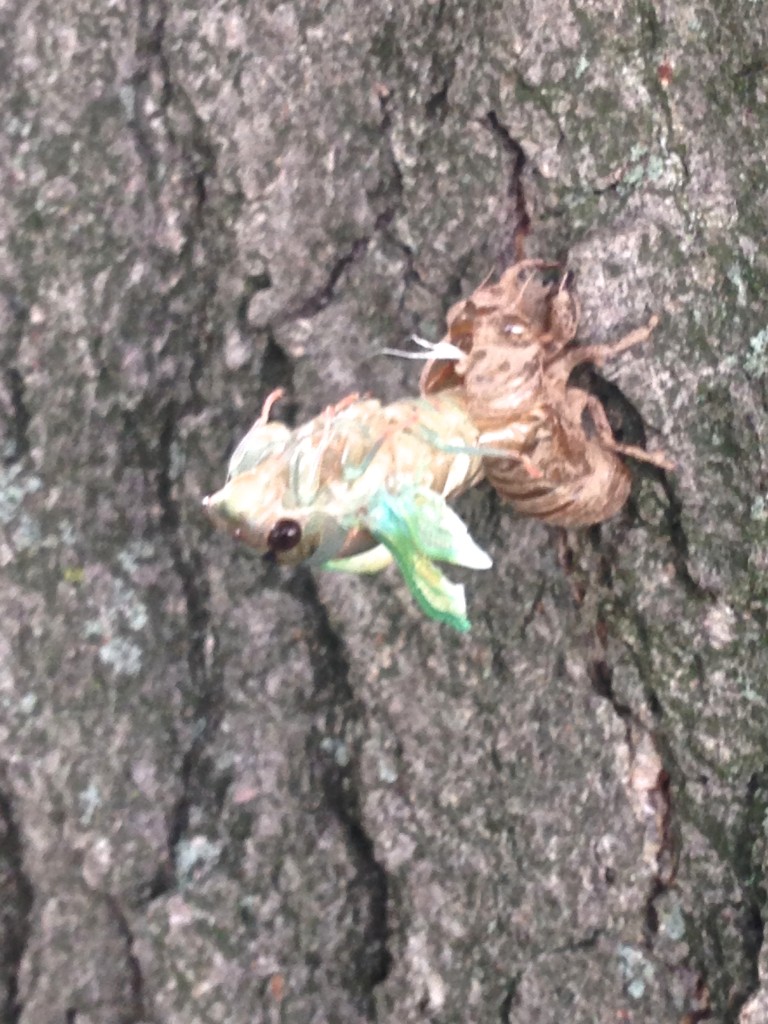
I pointed out the limp, curled wings of the cicada that was mid-molt (above) and compared it against the one who had completely emerged and straightened out its wings, allowing them to begin drying (below).

We found old molts on the ground and on the tree, and I passed them around so that the students could take home a souvenir.

Afterward, Jess compiled the students’ recordings and the next day they were able to see and measure the spectrograms of their recordings. You can see a couple of ambulance sirens at the bottom of this one.
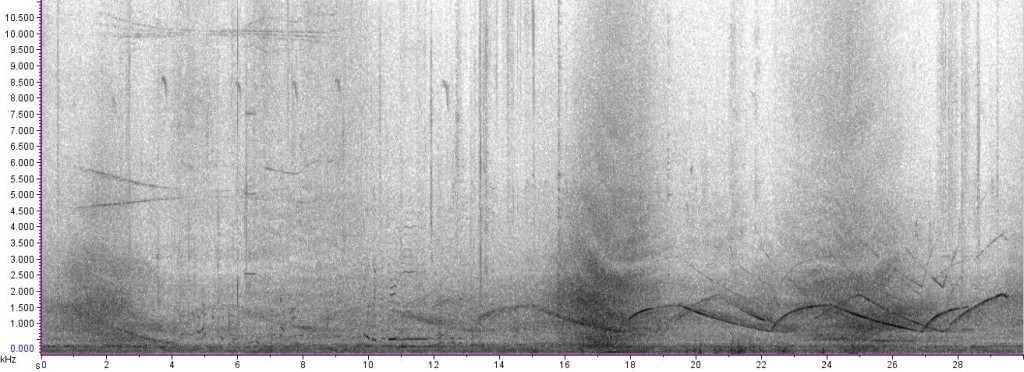
Overall the program seemed to be a success, and hopefully the students learned something new about insects and the world of bioacoustics!
Bonus: Here’s a video of the final emergence of one of the cicadas: Cicada Emergence
–Hannah
Adventures in Macro Photography
Although our insects are generally favorable as far as logistics and productivity, looking at tiny critters presents its own challenges. The insect work in the Parks Lab has inspired me to make several adjustments to my sense of scope.
Just as the telescoping lens is a necessity for fieldwork with whales, the macro lens provides a means of documenting our insect charges, tracking their growth from nymphs to adults, and even aiding in identifying species (often difficult with live, moving specimens).
There is just one problem: a steep learning curve.
I had never used a macro lens before—until a couple of weeks ago, I thought the “Macro” setting on my SLR camera was as good as it got. I have since learned that a macro lens is a prime lens that magnifies the image onto the camera sensor; a “true” macro lens creates a 1:1 ratio of the subject’s size in real life to its size on the sensor. More info here. Similar to the telescoping lenses we use for whale photo-identification, the macro lens takes a bit of experience, some knowledge about photography, a bit of finesse, and a whole boatload of patience, but once I get everything figured out, I have no doubt it will change the way that we see our creepy crawly friends.
I’m not even going to pretend to know enough yet to offer a macro tutorial, but I’ll let the rest of this post serve as a brief, photographic account of my own mishaps thus far in macro photography.
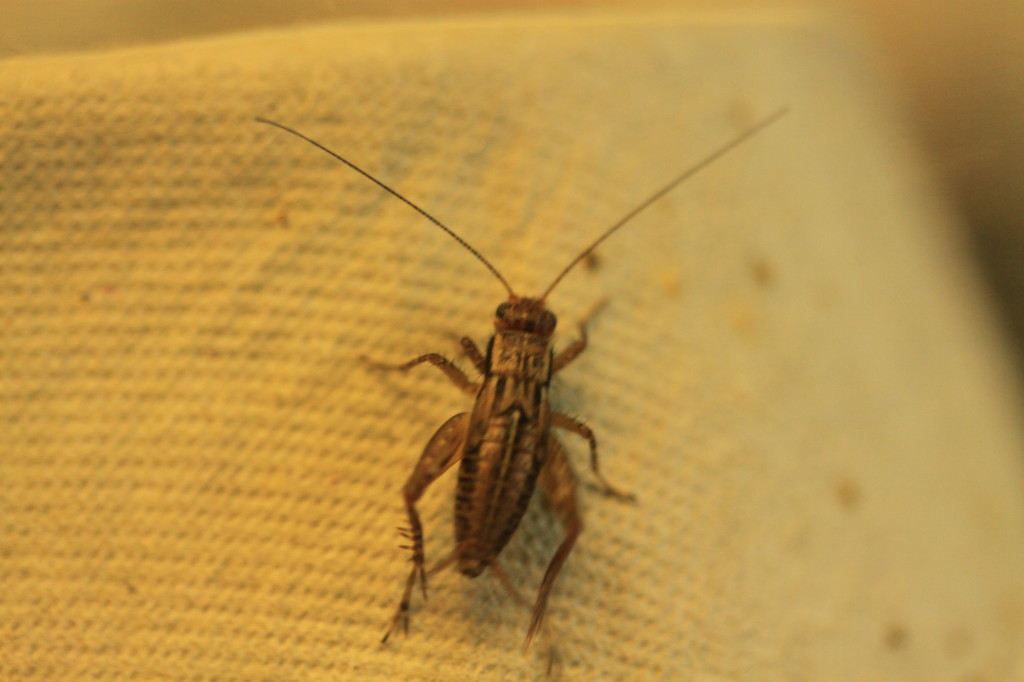
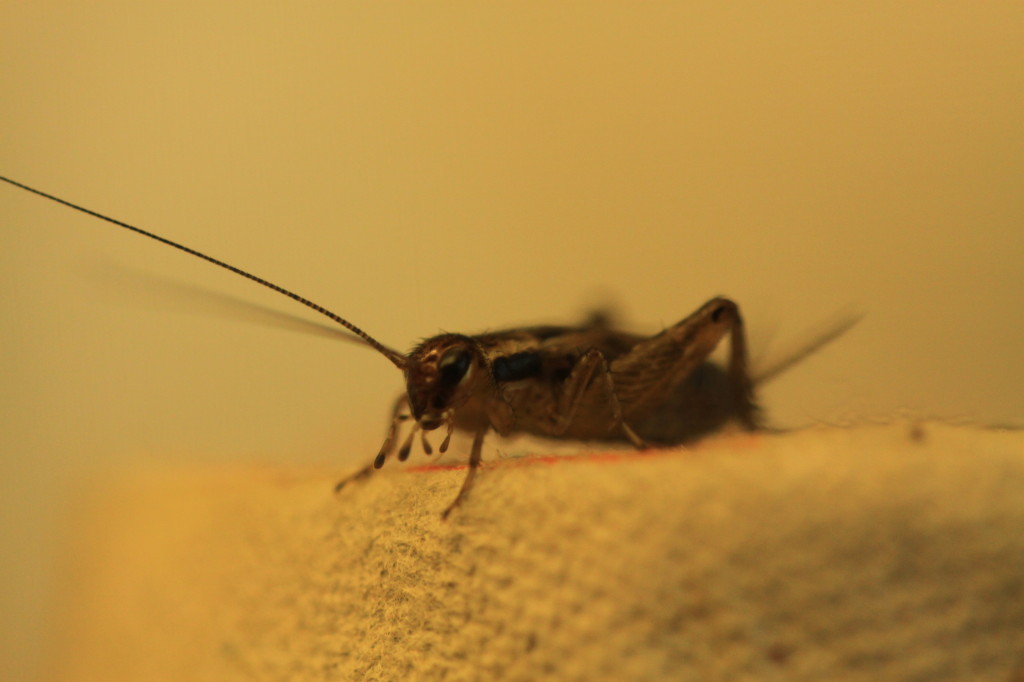
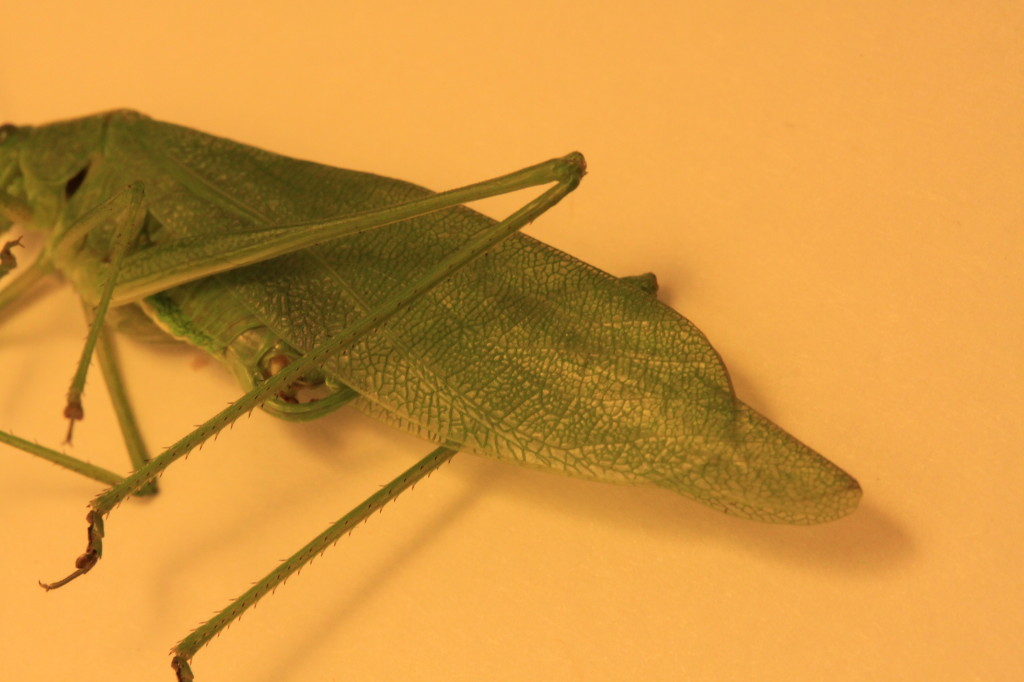
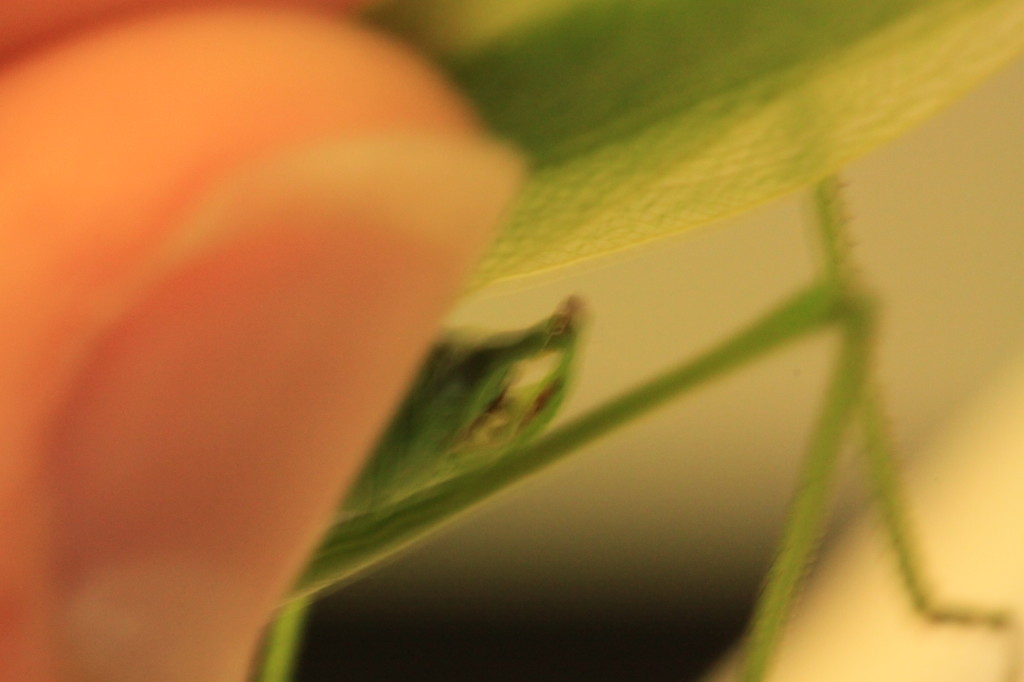
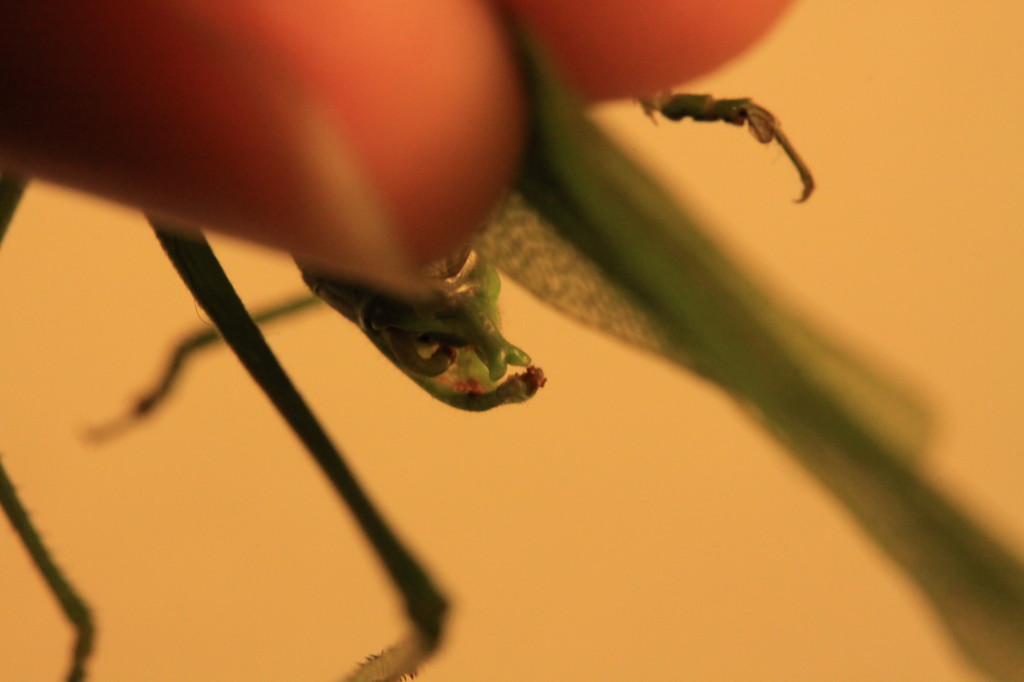
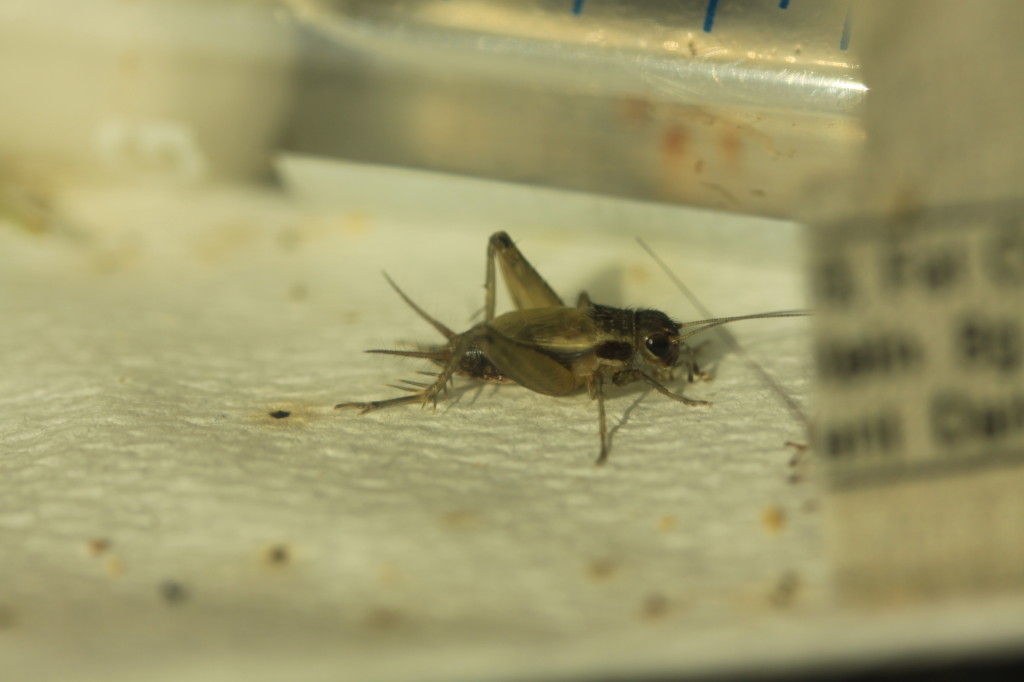
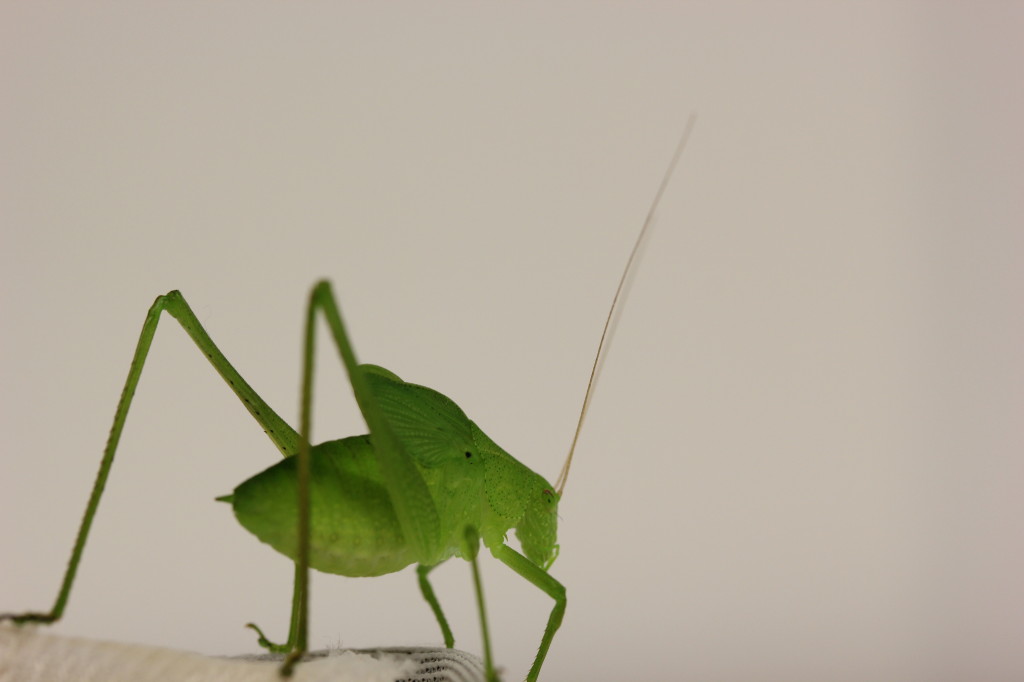

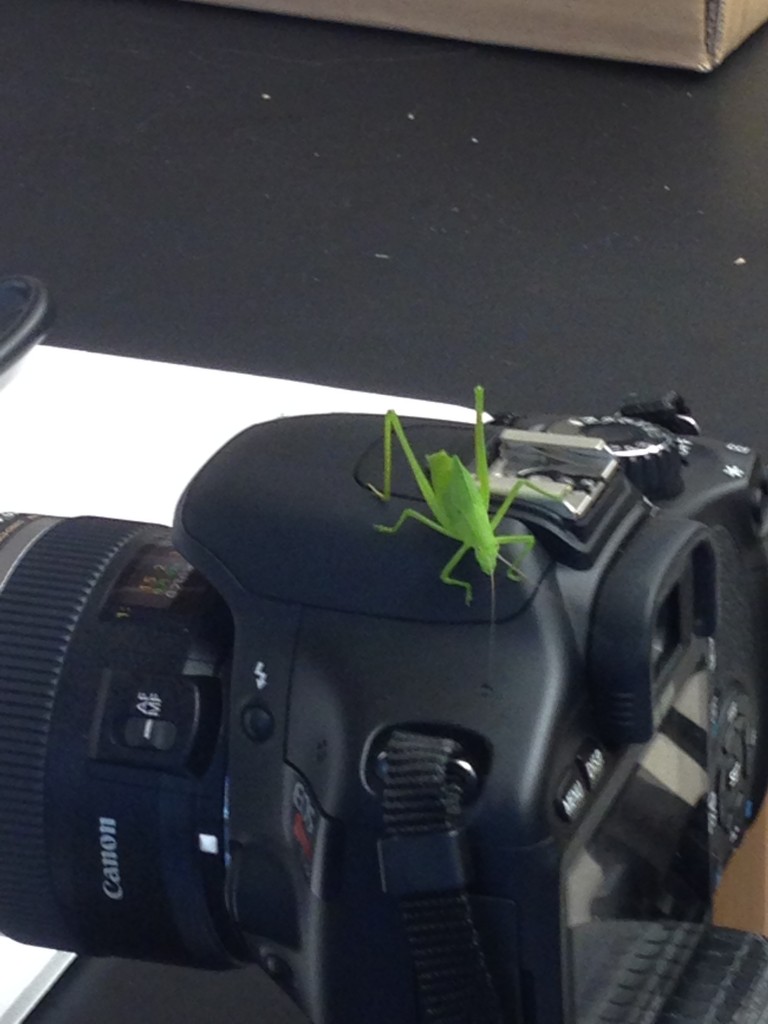
If you’re interested in using macro lenses to photograph your own insects, check out this site with some great tips!
–Jess
“This is either madness or brilliance”
Every scientific journey begins with an idea. These ideas can go one of two ways: 1) after countless trials and brainstorms, they actually work; 2) after countless trials and brainstorms, they don’t. I think you can guess which one happens more often.
This summer, I’ve been working out in Newport, Oregon at theHatfield Marine Science Center. Hatfield is operated by Oregon State University and hosts groups like the Cooperative Institute for Marine Resource Studies and the Marine Mammal Institute, as well as researchers and staff from Oregon Dept. of Fish & Wildlife, US Dept. of Fish & Wildlife, and NOAA. I’m here at Hatfield working on some of my dissertation research with the help of the ORCAA lab, Oregon State’s animal bioacoustics group. I came to the ORCAA lab as a visiting graduate student about a month ago with intentions of testing out some ideas.Ideas that, when I posed them, were more like off-handed comments to my advisor rather than valid approaches to realistic data collection.
Since my blogs seem to be few and far between these days, let me back up a tiny bit. I’m currently working on my PhD here in the Parks Lab at Syracuse. My interests are in pinniped behavior and physiology, and for my dissertation, I’m looking at the variation in male harbor seal mating behavior and its influence on reproductive success. I’m also interested in the effects of shipping noise on harbor seals during the breeding season, but that’s another blog post for another time.
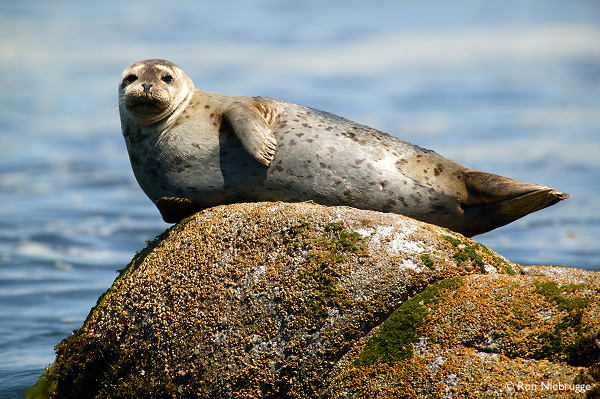
A few months ago, as I was furiously preparing for my PhD candidacy exam (one part proposal defense, one part general knowledge exam, all parts stressful), I met with Susan to discuss how I could get the data that I wanted for the project I was proposing. I wanted underwater movements of harbor seals during the breeding season. I wanted to map out male territories and really figure out how and where they were spending their time when they were below the surface. Harbor seals, along with the majority of phocids (i.e., true seals), mate underwater. Underwater behavior of any marine mammal is difficult to obtain. We, as researchers, are limited in our visual observations to what happens above water. The best method we have to tracking animals subsurface is tagging. But tagging is expensive, time consuming, and logistically difficult — it typically involves getting a boat and a team of able-bodied persons, capturing the animal, and gluing a tag to its fur. It’s doable, but not with solely my grad student resources. Susan and I began spitting out other ideas:
“What about how they track fish, like a tiny PIT tag?”
“Can we localize with a fish tag?”
“They do it for salmon, no?”
“But how could we get the tag on the seal?”
“Some sort of remote attachment, so you wouldn’t have to capture them.”
“Could we feed it to them?”
“That probably wouldn’t be a good idea…”
“I guess we could just shoot it at them in a paintball.”
And there you have it, ladies and gentleman. The mildly sarcastic comment that snowballed into a cross-country trip to Oregon and countless hours of researching glues and paintballs.

After a bit of post-meeting research, I came across some small high frequency acoustic transmitters (made by Vemco, pictured on the right) that are used to study fish movement. They’re small, only about 16mm in length, and they emit 180 kHz signals about every 30 seconds. These acoustic signals are picked up on receivers that are strategically moored in the study site. By looking at differences in the times of arrival of specific signals, it’s possible to determine the location of the transmitter, i.e. the tag, i.e. the animal of interest. Acoustic tags are great for looking at subsurface behavior because of how efficiently sound travels underwater (it’s much more efficient compared to air – you can read more about that here). These tags seemed perfect! They were small enough to fit in a paintball, they were the right kind of tag for studying underwater movement of individuals, and they emitted signals that were above the hearing threshold of harbor seals (and killer whales)*.
*Researchers have also used 69 kHz tags (instead of 180 kHz) to monitor fish populations. The problem with these tags is that seals and sea lions can hear at 69 kHz. Implanting a tag that emits a sound in the hearing range of the fish’s predator is basically attaching a dinner bell to the study organism. When considering using acoustic tags on the seals, I wanted to make sure that they (and their predators) couldn’t hear the acoustic signal being emitted. That way I could avoid any potential behavioral disturbance (or increased predation) caused by the sound coming from the tag.
I took my PhD candidacy exam, finished the semester, and packed my bags for Oregon, where ORCAA commander in chief Holger Klinck had agreed to help me test this weird tag attachment idea.
Current emotions: Excited.
Things we had to figure out:
- How do we get the tag inside the paintball?
- What kind of glue do we use? – something that doesn’t solidify inside the paintball, but cures almost immediately to the seal…hmmm does this product even exist?
- How do we close the paintball once the tag and the glue are inside?
- Will it actually stick to the seal? – we were going to need a real seal to test that one…
And thus began the Amazon binge-purchasing. I bought glues. Super glues. Rapid cure super glues. Super instant curing no drip super glues. Veterinary grade surgical glues. One-minute instant mix two-part epoxies. Clear-dry power grip instant grab all-purpose interior adhesives. I also bought some regular paintballs and some empty paintball shells. And thanks to my paintballing sister, I already had the gun.
Current emotions: Overwhelmed – who knew there were so many options for adhesives?
The next step was to get the tag into the shell and fill it with glue. This took a bit of finagling, but I finally did it! I was so proud! I made three types of paintball tags. The first were regular paintballs that I emptied, stuffed with a tag, and filled with super glue (the green ones in the picture below). I sealed them with some glue and a sprinkle of baking soda. It turns out that baking soda is an accelerant for cyanoacrylates (fancy name for super glue). A tiny bit of baking soda and BOOM that super glue is SOLID. The second type of tag ball was basically the same as the first, but I used the empty paintball shells. Bonus – no emptying of paint required (the clear ones in the picture below). I was most proud of the third kind. These were half filled with super glue and half filled with baking soda. In theory, when it hit the seal, the tag would cure instantly to the fur of the animal because of the addition of the accelerant.
Current emotions: Feelin’ creative and accomplished.
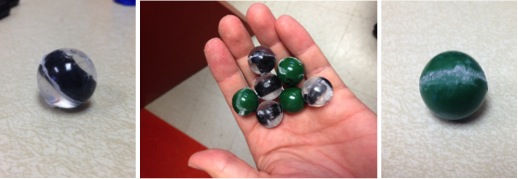
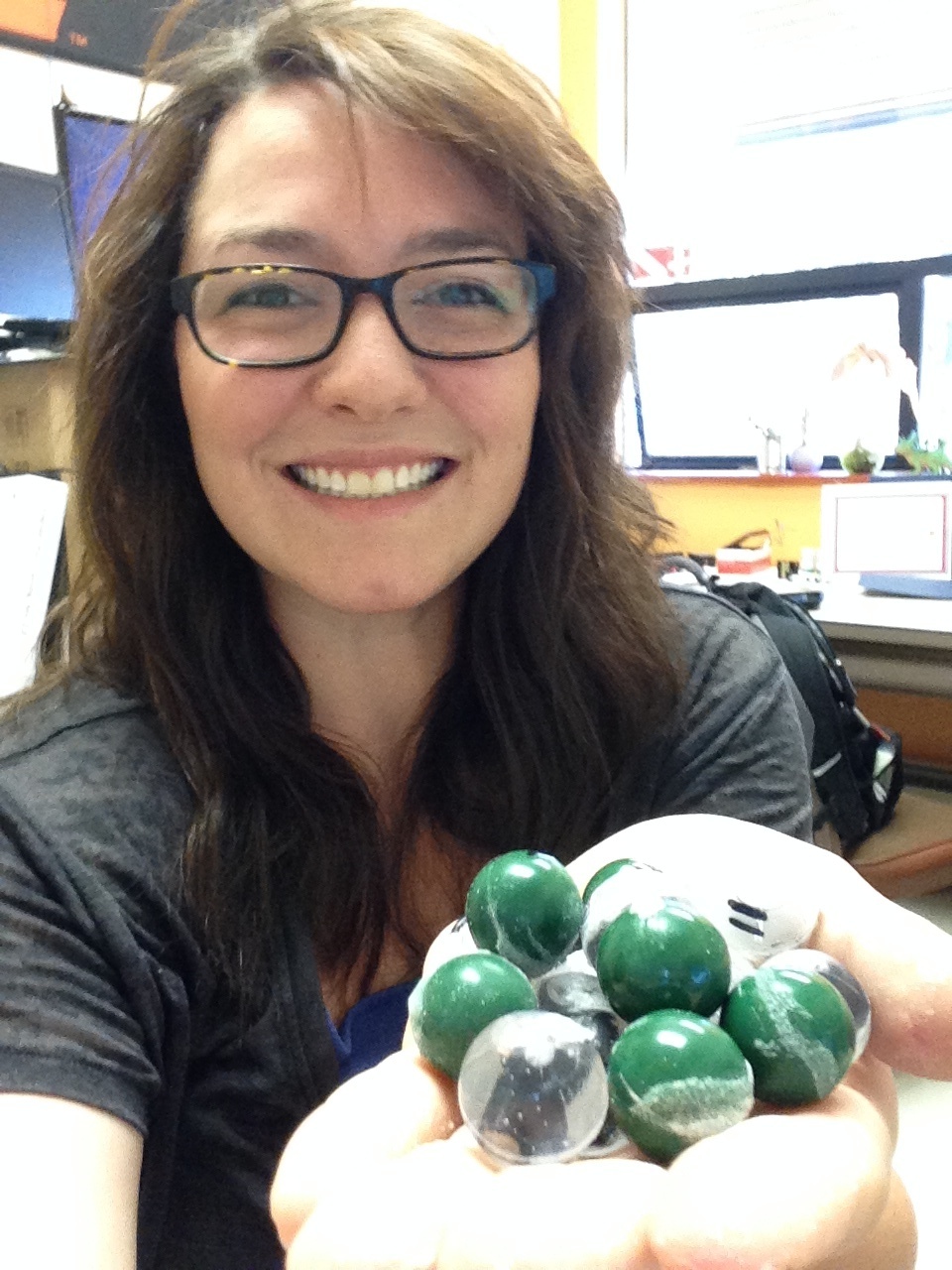
I’m going to keep this long post from becoming too long and just tell you that it didn’t work. No tags stuck to anything.
Current emotions: Disappointed 🙁
But this is science! So what do we do? We brainstorm more ideas! And what do we do when those don’t work either?? We brainstorm even more ideas! I went from my failed paintballs, to thinking about crossbows, tiny pistol crossbows, compound and recurve bows, drones (no one would buy me drones though…). After lots of trial and error, with an emphasis on the error, I landed on the pistol crossbow. It was small, manageable, and didn’t have too much power. I crafted some bolts out of wooden dowels, foam floats, electrical tape, PVC end caps, fishing line, empty paintball shell halves (might as well use them if I’ve already got them, right?), and of course, duct tape. With a little finesse and the right adhesive, I shot these homemade arrows out of my little crossbow and somehow got a tag to stick to my target. I. was. shocked. Did all of my brainstorming actually just pay off??
Current emotions: Chest-pounding, can-crushing, fire-breathing, unstoppable POWER.
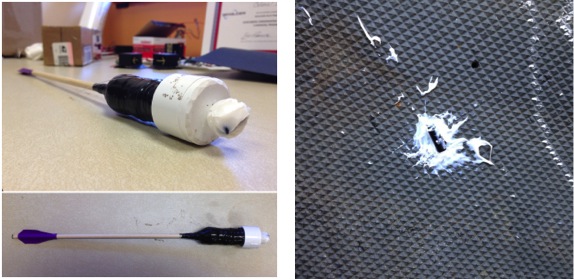
At this point it had been a roller coaster of successes and failures, which I thought was going to end with my, what could only be described as, legendary tagging success. However, after some preliminary field-testing, it was revealed that in order to make these tags work in the locations I wanted them to work, I would have to outfit the study area with an impractical number of receivers. Had all the time and research and effort and crossbow target practice all been for naught? Probably.
Current emotions: Uggggghhhhh seriously?? COME ON. I just got the tags to stick!
Back to the drawing board. Conversations with Holger, conversations with Susan, and conversations with Holger and Susan at the same time led us all to the conclusion that the classic tagging approach would probably be the most logical way to go about getting my data. Luckily, it’s looking like I’ll be able to collaborate with some other groups here in Newport on a tagging trip that’s already planned for next year. My sample size will be lower, it’s not exactly the data that I thought I was going to get, it’s not even in the same field site I thought I’d be working, but thus is life. As a scientist, you can’t be married to a certain data collection method or even to a certain location. You have to keep the big picture in mind – what were the original scientific questions/objectives? If you’re still able to get at these major objectives, then you’re probably still doing alright. Any data I can get to better understand the underwater mating behavior of these seals is beneficial for conservation and even just marine mammal biological knowledge in general. There’s still so much we don’t know about the organisms that live in our oceans (even ones like seals that spend part of their lives on land), but slowly and surely, we’re picking away at the mysteries.
Current emotions: Back to being excited. This scientific journey, though so far has been more madness then brilliance, is only just beginning. New pinniped adventures await!
-Leanna Matthews, PhD Candidate